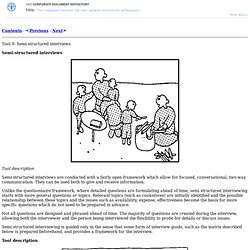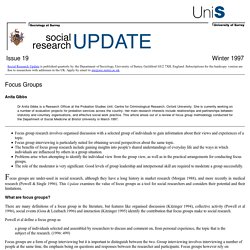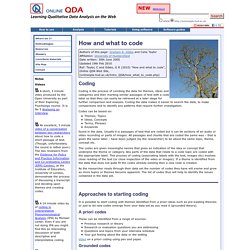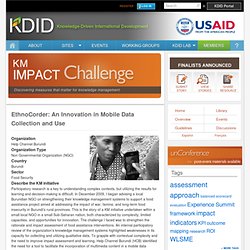

Sample size for qualitative research. Editor’s note: Peter DePaulo is an independent marketing research consultant and focus group moderator doing business as DePaulo Research Consulting, Montgomeryville, Pa.

In a qualitative research project, how large should the sample be? How many focus group respondents, individual depth interviews (IDIs), or ethnographic observations are needed? We do have some informal rules of thumb. For example, Maria Krieger (in her white paper, “The Single Group Caveat,” Brain Tree Research & Consulting, 1991) advises that separate focus groups are needed for major segments such as men, women, and age groups, and that two or more groups are needed per segment because any one group may be idiosyncratic. Another guideline is to continue doing groups or IDIs until we seem to have reached a saturation point and are no longer hearing anything new. Such rules are intuitive and reasonable, but they are not solidly grounded and do not really tell us what an optimal qualitative sample size may be. Semi structured interviews.
Contents - Previous - Next Tool 9: Semi-structured interviews Semi-structured interviews Tool description Semi-structured interviews are conducted with a fairly open framework which allow for focused, conversational, two-way communication.

Unlike the questionnaire framework, where detailed questions are formulating ahead of time, semi structured interviewing starts with more general questions or topics. Not all questions are designed and phrased ahead of time. Semi-structured interviewing is guided only in the sense that some form of interview guide, such as the matrix described below is prepared beforehand, and provides a framework for the interview.
Tool description Purpose of the tool • Obtain specific quantitative and qualitative information from a sample of the population • Obtain general information relevant to specific issues, (ie: to probe for what is not known) • Gain a range of insights on specific issues Major benefits Help field staff become acquainted with community members. 1. 2. Semi Structured Interview Case Study. Structured Interviews. FOCUS GROUPS. Social Research Update is published quarterly by the Department of Sociology, University of Surrey, Guildford GU2 7XH, England.

Subscriptions for the hardcopy version are free to researchers with addresses in the UK. Apply by email to sru@soc.surrey.ac.uk. Focus Groups Anita Gibbs Dr Anita Gibbs is a Research Officer at the Probation Studies Unit, Centre for Criminological Research, Oxford University. Focus group research involves organised discussion with a selected group of individuals to gain information about their views and experiences of a topic.
Focus groups are under-used in social research, although they have a long history in market research (Morgan 1988), and more recently in medical research (Powell & Single 1996). What are focus groups? Powell et al define a focus group as a group of individuals selected and assembled by researchers to discuss and comment on, from personal experience, the topic that is the subject of the research. (1996: 499) When to Use Focus Groups. The SAGE handbook of qualitative ... Text Coding, De Coding. Authors of this page: Graham R.

Gibbs and Celia Taylor Affiliation: University of Huddersfield Date written: 30th June 2005 Updated 19th Feb 2010 Ref: Taylor, C and Gibbs, G R (2010) "How and what to code", Online QDA Web Site, [onlineqda.hud.ac.uk/Intro_QDA/how_what_to_code.php] Coding Coding is the process of combing the data for themes, ideas and categories and then marking similar passages of text with a code label so that they can easily be retrieved at a later stage for further comparison and analysis. Codes can be based on: Themes, Topics Ideas, Concepts Terms, Phrases Keywords found in the data. The codes are given meaningful names that gives an indication of the idea or concept that underpins the theme or category. As the researcher reads through their data set the number of codes they have will evolve and grow as more topics or themes become apparent. Approaches to starting coding A priori codes These can be identified from a range of sources: Grounded codes "What is going on?
Table 1. EthnoCorder: An Innovation in Mobile Data Collection and Use. Organization Help Channel Burundi Organization Type Non Governmental Organization (NGO) Describe the KM initiative Participatory research is a key to understanding complex contexts, but utilizing the results for learning and decision-making is difficult.

Describe the approaches utilized to measure / assess this KM initiative Several methods were used to assess this initiative; in fact, EthnoCorder provided a platform for self-assessment. What was the purpose or motivation for assessing this KM initiative? We share our donors' interest in validating EthnoCorder's ability to support HCB's internal learning processes, and its ability to respond to the general inadequacy of food assistance impact research. What were the most important lessons learned about the assessment process? What would you do differently next time? Some results of this KM initiative are already apparent. What advice would you give to others based on your experience? As a leader, systems intelligence is exceedingly important.